Replacing just 20 minutes of sitting with brisk movement daily lowers all-cause mortality risk by 16%, according to CDC research. This simple swap requires no equipment, memberships, or special skills – only consistent steps toward better health. What if the cheapest fitness solution was literally right outside your door?
Science confirms that regular ambulation does more than burn calories. A 2023 Johns Hopkins study found participants who maintained 150 weekly minutes of moderate-paced strides saw 20% lower heart disease risk and improved insulin sensitivity. The CDC reports this accessible activity prevents 1 in 10 premature deaths in the U.S., rivaling prescription medications for chronic disease prevention.
Beyond cardiovascular benefits, weight-bearing movement strengthens bones better than swimming or cycling. Researchers at Mayo Clinic observed 3% annual bone density improvements in postmenopausal walkers – a key factor in preventing osteoporosis. Dr. Linda Hartsook, a preventive medicine specialist, advises: “A quick medical check ensures you maximize benefits while addressing individual health considerations.”
Key Takeaways
- Daily 20-minute sessions significantly reduce chronic disease risks
- Step-based routines improve heart health as effectively as some medications
- Weight-bearing motion combats age-related bone density loss
- Medical clearance optimizes safety for those with existing conditions
- Mood enhancement occurs through natural endorphin release
Walking for Weight Loss: The Cheapest Fitness Plan Ever Explained
When money gets tight, you don’t have to skip your fitness goals. Walking is a great zero-equipment option that fits any lifestyle. It’s cheaper than expensive workout trends and gives lasting results without spending a lot. Let’s see why it beats going to the gym.

Economic Advantages Over Gym Memberships
Gym memberships in the U.S. cost about $58 a month, or $700 a year. Walking, on the other hand, only needs a good pair of shoes. Here’s a comparison:
| Expense Type | Gym Membership (Yearly) | Outdoor Walking |
|---|---|---|
| Base Cost | $696 | $0 |
| Equipment Fees | $120 | $0-$150* |
| Transportation | $240 | $0 |
| Total | $1,056 | $0-$150 |
*One-time shoe purchase, replaced annually
Hidden Fees Avoidance
Gyms often charge extra for:
- Initiation fees ($50-$200)
- Class reservations
- Cancellation penalties
Walking avoids these extra costs. Fitness expert Linda Hartsook says:
“Weather isn’t a barrier—layer clothing for winter walks or find indoor malls during summer heat.”
Accessibility Factors
Walking routes are everywhere, whether in cities or countryside. Your location changes the scenery, not the workout’s effectiveness.
Urban vs Rural Opportunities
City folks can use:
- Sidewalk networks
- Public staircases
- Park loops
Rural walkers enjoy:
- Nature trails
- Farm roads
- Backyard circuits
Time Flexibility Benefits
You decide when and how long to walk. No rush to gym hours or waiting for equipment. Studies show short walks throughout the day burn calories as well as long sessions.
This cheapest fitness plan fits any schedule. Use free apps like MapMyWalk to track your progress without paying for subscriptions.
The Physiology of Weight Loss Through Walking
Your daily walk does more than burn calories. It starts complex processes that turn simple steps into powerful fat-burning sessions. Let’s look at how your body reacts to this easy exercise at the cellular and hormonal levels.
Fat Oxidation Processes
Walking starts fat oxidation when you stay at 60-70% of your maximum heart rate (MHR). This is the best zone for burning stored fat for energy. To find this zone, use Hartsook’s formula:
Target Heart Rate = [(220 – Age) – Resting Heart Rate] × 0.6 + Resting Heart Rate
Use the Borg RPE scale too. Aim for a 12-14 on a 6-20 scale. This helps you work hard without getting too tired.

Your aerobic threshold is when fat burning is at its peak. For most, this is at:
- 60-70% MHR
- 55-75% VO2 max
Working in this range burns more fat and keeps muscle mass.
Respiratory Exchange Ratios
Your respiratory exchange ratio (RER) shows if you’re burning carbs or fats. Walking usually keeps RER below 0.85. This means over 50% of energy comes from fat stores. Longer walks at a moderate pace lower this ratio even more.
Hormonal Responses
Regular walking changes your hormones in two key ways:
Insulin Sensitivity Improvements
Daily walks make your cells 43% more responsive to insulin (Journal of Applied Physiology). This helps control blood sugar and cuts down fat storage signals, mainly after meals.
Cortisol Regulation Effects
Rhythmic walking motions lower cortisol levels by 15-25% during and after exercise. This stress hormone drop:
- Decreases abdominal fat storage
- Improves sleep quality
- Reduces sugar cravings
Essential Walking Gear on a Budget
Starting a walking routine doesn’t need to cost a lot. You can find low-cost weight loss exercise options that are both comfortable and safe. Here’s what you need without spending too much.
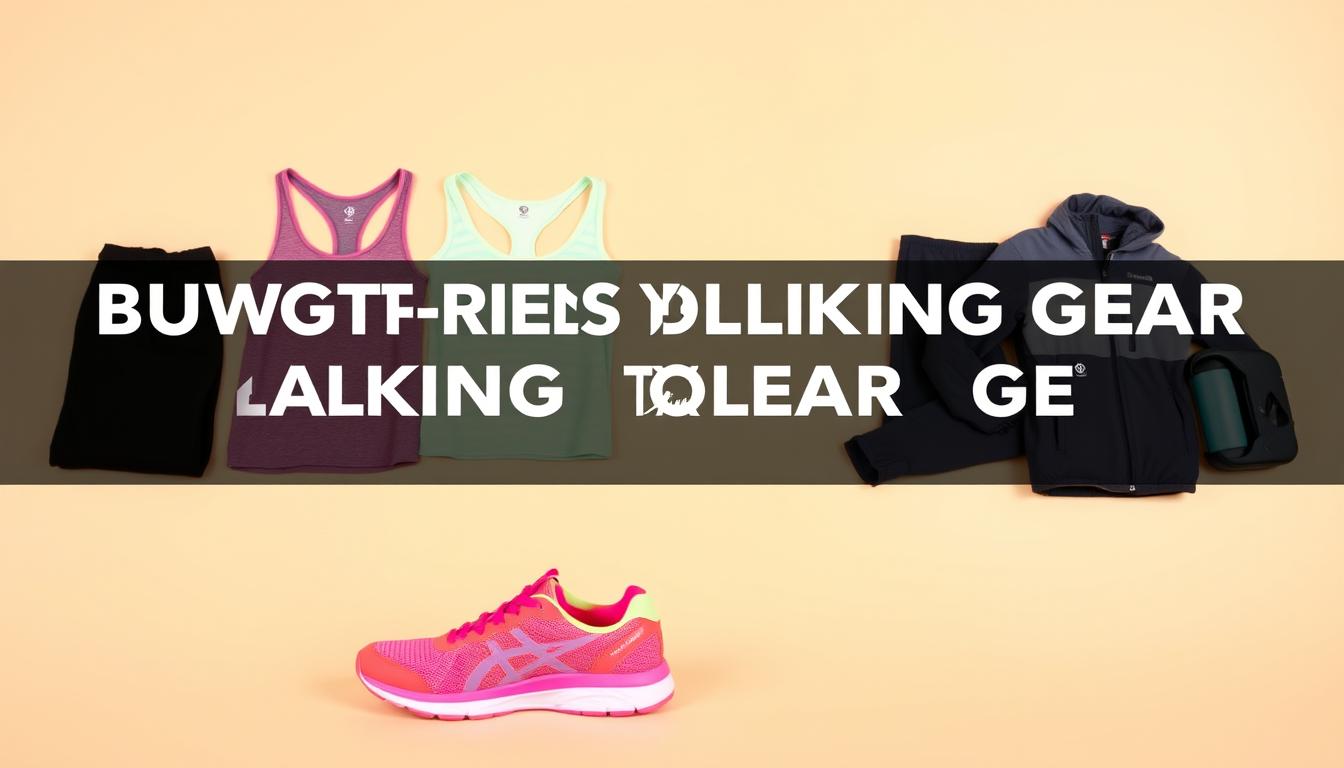
Shoe Selection Criteria
Your shoes are key for every walk. The American Podiatric Medical Association says fit, arch support, and shock absorption are must-haves. We’ll show you how to find good deals without sacrificing quality.
Arch Support Requirements
Do you have flat feet or high arches? Look for shoes with removable insoles. Brands like ASICS and Brooks have affordable models with adaptive arch technology. Try on shoes in the afternoon when your feet are at their largest. Your toes should have some room to wiggle.
Durability vs Cost Balance
While cheaper shoes might seem like a good deal, they can cost more in the long run. Here’s a comparison:
| Brand | Price | Mileage Rating |
|---|---|---|
| New Balance 624 | $65 | 500 miles |
| Skechers Go Walk | $55 | 300 miles |
| Saucony Jazz | $75 | 600 miles |
Clothing Essentials
Wearing comfortable clothes helps you stick to your routine. Look for functional items, not just trendy ones. Thrift stores often have great deals on quality pieces.
Moisture-Wicking Fabric Types
Polyester blends are better than cotton because they pull sweat away from your skin. Check secondhand stores for:
- Coolmax® technology
- Polypropylene layers
- Merino wool blends (surprisingly affordable)
Layering Systems for All Seasons
Control your body temperature with a 3-layer system:
- Base layer: Thin moisture-wicking shirt
- Mid layer: Fleece or lightweight sweater
- Outer layer: Windproof jacket (look for sales at Decathlon)
Remember, a good low-cost weight loss exercise plan focuses on practical, versatile items. Choose pieces that work for different seasons and places.
Step-by-Step Walking Plan Creation
To lose weight through walking, you need a plan that fits your fitness level. This guide helps you create a walking routine that grows with you. It keeps you motivated and moving forward.
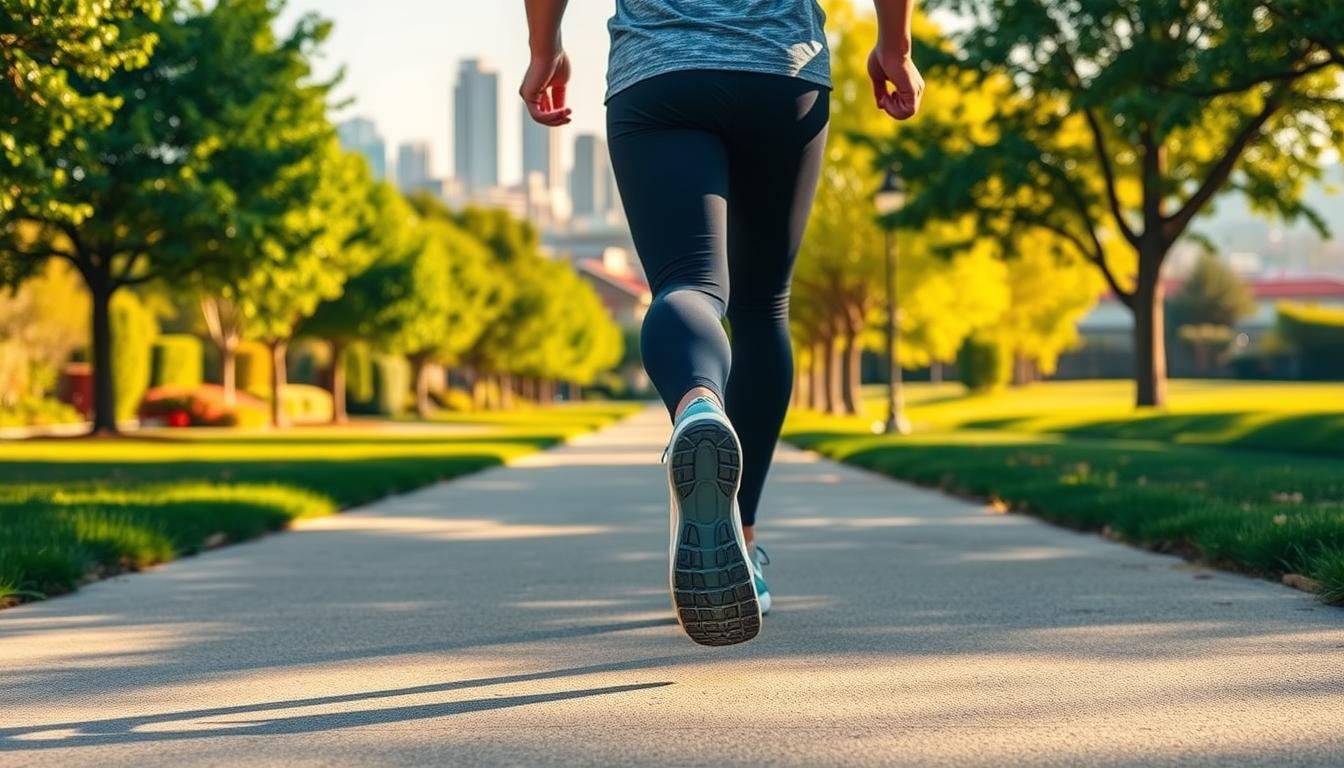
Baseline Assessment
First, find out where you start. A good check-up makes sure your plan is right for you. It helps avoid getting too tired or hurt.
Initial Fitness Test Protocol
Here’s a simple test from the American College of Sports Medicine (ACSM):
- Walk at a moderate pace for 15 minutes straight
- Record how far you walk
- Check how fast your heart rate goes back down after walking
“Proper warm-ups reduce injury risk by 48% in walking programs.”
Realistic Goal Setting Framework
Use the SMART method for setting goals:
- Specific: “Walk 5 days weekly” vs. “Walk more”
- Measurable: Track distance or step count
- Achievable: Start with 20-minute sessions
- Relevant: Align with weight loss targets
- Time-bound: Set 4-week milestones
12-Week Progression Model
This plan combines Hartsook’s 7-week base with interval training for better fat burning. Use free apps like MapMyWalk for feedback as you go.
Phase 1: Foundation Building (Weeks 1-4)
| Frequency | Duration | Intensity |
|---|---|---|
| 5 days/week | 25 minutes | 55-65% max heart rate |
| 2 rest days | +5 min weekly | Perceived exertion 4/10 |
Phase 2: Intensity Introduction (Weeks 5-8)
Add interval training with the 3:1 ratio:
- 3 minutes brisk walking
- 1 minute recovery pace
- Repeat 6 cycles
Phase 3: Advanced Adaptation (Weeks 9-12)
| Focus | Terrain | Calorie Burn* |
|---|---|---|
| Hill repeats | 5% incline | +40% vs flat |
| Speed drills | Track/trail | 18 cal/min |
*Based on 160-lb individual
Advanced Calorie-Burning Techniques
Ready to boost your walking routine? These methods can burn up to 67% more calories than regular walking. They keep your joints safe too. Let’s look at two powerful ways backed by fitness experts.
Nordic Walking Benefits
This Scandinavian technique turns walking into a full-body workout. Studies show Nordic walkers burn 20-46% more calories than regular walkers at the same speed, according to ACE fitness data.
Upper Body Engagement Methods
Push through the poles like you’re cross-country skiing. Keep your elbows at 45 degrees and:
- Plant poles behind your bodyline
- Engage core muscles during push-off
- Alternate arm swings naturally with steps
Pole Selection Guide
Choose telescopic poles that adjust to 68% of your height. Look for:
- Carbon fiber shafts (durable yet lightweight)
- Ergonomic grips with wrist straps
- Interchangeable tips for pavement/terrain
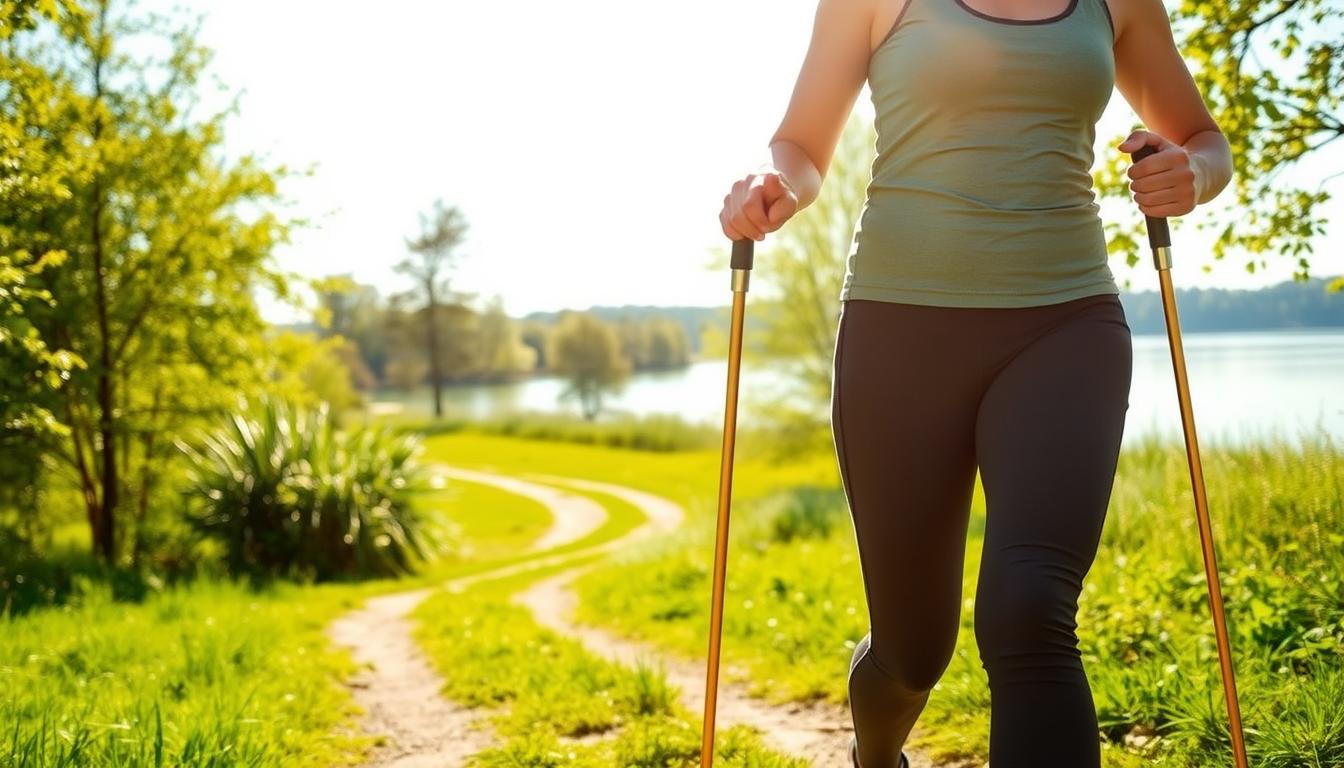
Weighted Walking Strategies
Adding resistance boosts metabolism while walking. Follow the 20% weekly progression rule – never increase weight more than one-fifth of your current load each week.
Ankle Weight Safety Protocols
Start with 1-2 lb weights per ankle. Always:
- Position weights above ankle bones
- Limit use to 30-minute sessions
- Remove immediately if numbness occurs
Backpack Loading Techniques
Pack weight close to your spine using this distribution:
| Position | Weight % | Items |
|---|---|---|
| Upper Back | 40% | Water bladder, rolled towels |
| Mid Back | 50% | Sandbags, rice packs |
| Hip Belt | 10% | Energy bars, small weights |
“Altitude mask training can complement weighted walks by improving respiratory endurance, but always prioritize proper form over added resistance.”
Nutritional Optimization for Walkers
Adding the right nutrition to your walks can boost your results without spending a lot. This affordable fitness regimen works better when you use these proven nutrition tips.

Macronutrient Mastery
Make sure your diet matches your walking level. The American College of Sports Medicine suggests eating 3-5 grams of carbs per pound of body weight each day.
Carb Cycling Made Easy
Here’s a simple way to do it:
| Walk Intensity | Carb Grams/Lb | Meal Example |
|---|---|---|
| Easy Day | 2-3g | Oatmeal + berries |
| Long Walk | 4-5g | Sweet potato + chicken |
Protein Power Timing
Eat 20g of protein within 45 minutes after walking. Try these smoothie recipes for quick recovery. Greek yogurt or eggs are good choices for those on a budget.
“Proper protein timing turns walking into a body-shaping tool”
Hydration Science Simplified
How much water you need depends on how long you walk:
- 30-60 mins: 17-20 oz water
- 90+ mins: Electrolyte drink
DIY vs Store-Bought Electrolytes
| Solution | Cost/Serving | Sodium Content |
|---|---|---|
| Homemade | $0.12 | 300mg |
| Commercial | $1.50 | 500mg |
Avoid Overhydration Risks
Check your weight before and after walking. If you gain weight, you’re drinking too much. Stick to 16-24 oz per hour during intense walks.
Nutrition doesn’t have to be expensive. Focus on whole foods and smart timing to get the most out of your affordable fitness regimen.
Technology Integration for Success
Smart devices and apps make walks more effective and affordable. They help you control your inexpensive weight loss program without the need for expensive gym equipment. Let’s look at how to use these tools well.
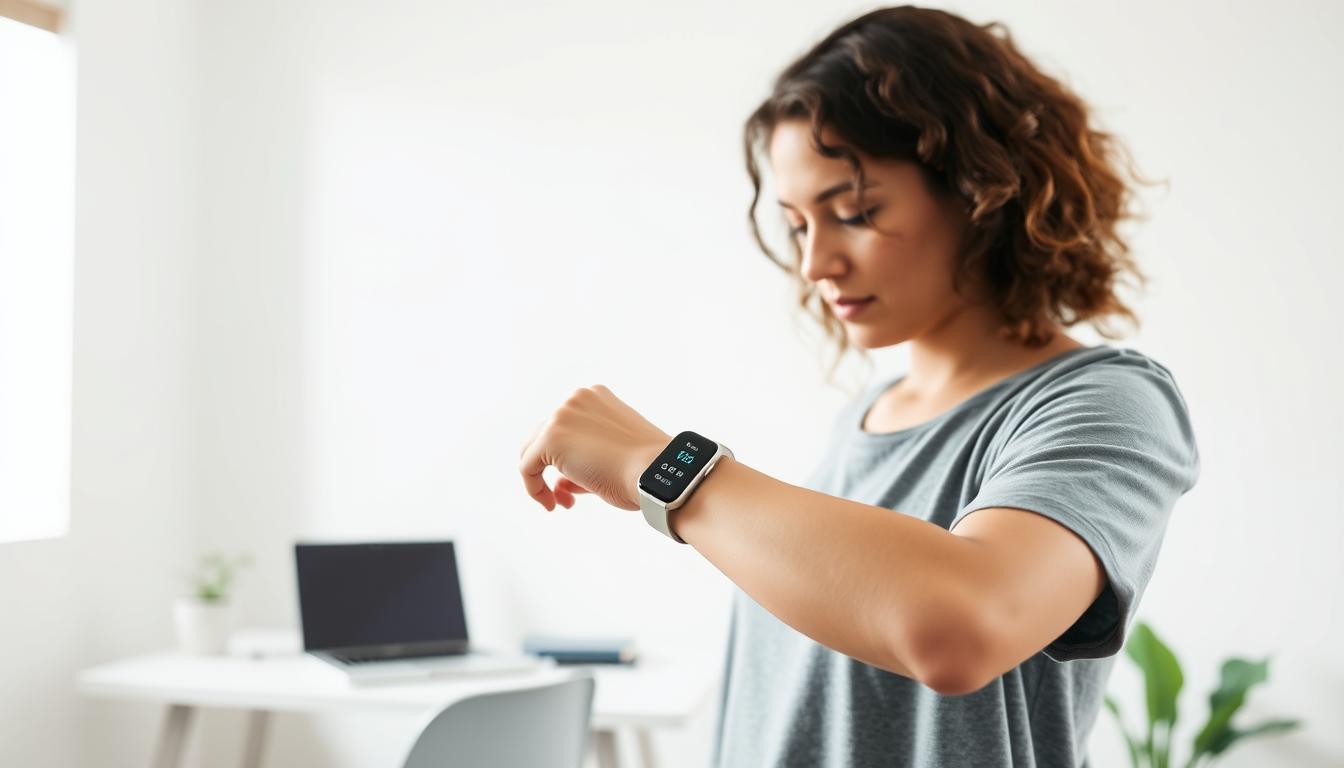
App-Based Tracking
Free apps offer great features without costing much. MapMyWalk tracks routes, counts calories, and gives audio feedback. While Strava Premium offers more, many find free apps enough.
MapMyWalk Features Breakdown
- Real-time pace analysis
- Elevation gain tracking
- Customizable interval alerts
Using apps in the background saves battery. Turn off push notifications to keep your phone charged during walks.
Apple Health Integration
Apple Health combines data from various apps. It shows daily steps and active calories. Use “Prioritize Walking” mode to focus on walking data.
Wearable Technology
Fitness trackers offer insights without needing your phone. Here’s a look at two budget-friendly devices:
| Feature | Fitbit Inspire 3 | Xiaomi Mi Band 8 |
|---|---|---|
| Heart Rate Accuracy | ±2 bpm variance | ±5 bpm variance |
| Battery Life | 10 days | 14 days |
| Price | $99.95 | $49.99 |
Heart Rate Zone Training
Working out at 60-70% of your max heart rate burns fat well. Most trackers buzz if you’re out of this zone. For a 40-year-old, aim for 108-126 bpm.
“Zone 2 training increases fat oxidation by 58% compared to high-intensity intervals for weight loss.”
Overcoming Common Challenges
Keeping up with a walking routine can be tough. Life gets in the way, and it’s easy to lose focus. But, with the right planning and mindset, you can overcome these obstacles. Let’s look at how to handle time issues and staying motivated.

Time Management Solutions
You don’t need a lot of time to make progress. Studies show that 10-minute micro-walking sessions throughout the day can be just as good as longer workouts. Here’s how to make them work for you:
Micro-Walking Sessions
- Walk during TV commercials or phone calls
- Set hourly reminders for 3-minute brisk walks
- Pair short walks with routine tasks (e.g., walking while brewing coffee)
Commute Integration Tactics
Make your commute a chance to get fit. Try these changes:
| Traditional Commute | Walking-Enhanced Version |
|---|---|
| Drive entire route | Park 15 minutes away and walk |
| Take elevator to office | Use stairs for 2-3 floors |
| Lunch at desk | 10-minute post-meal walk |
Motivation Maintenance
Staying consistent is easier with rewards and seeing progress. Here are ways to keep yourself motivated:
Reward System Implementation
Give yourself non-food rewards for reaching goals. For example:
- New walking shoes after 30 consistent days
- Massage therapy upon completing a 5K event
Progress Visualization Methods
| Tool | Benefit | Frequency |
|---|---|---|
| Fitness tracker app | Real-time step counts | Daily |
| Photo journal | Visual body composition changes | Weekly |
| Social sharing | Accountability through community | Monthly |
Use habit-stacking—like walking while listening to podcasts—to make walking a natural part of your day. Every step brings you closer to your goal.
Walking for Different Fitness Levels
Walking is great for everyone, whether you’re getting back into shape or training hard. It’s flexible and helps with weight management for all fitness levels. We’ll look at ways to make your walks effective and safe.
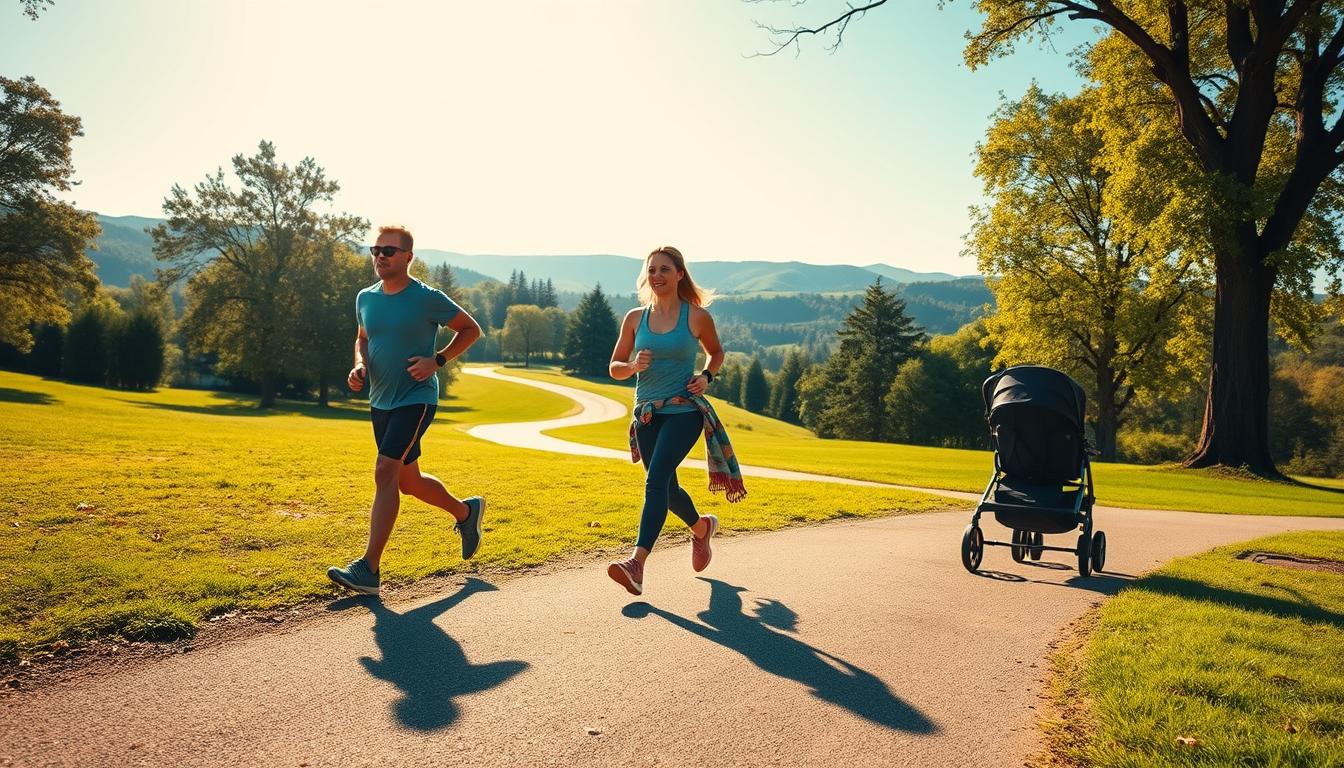
Beginner Modifications
Beginners should start slow to build a habit. If you have joint pain or can’t move much, small changes can help. They keep you moving without too much strain.
Seated Walking Alternatives
Seated marches are good when standing is hard. Try these:
- Alternate knee lifts while sitting upright
- Use hand weights during arm swing motions
- Combine leg extensions with upper-body movements
Seated exercises burn 90-120 calories in 30 minutes. They also boost blood flow. This is great for people with arthritis or after surgery.
Pool Walking Benefits
Walking in the water is easier on your joints and strengthens muscles. Chest-high pool sessions:
- Increase calorie burn by 50% compared to regular walking
- Enhance balance through water turbulence
- Allow longer workout durations without discomfort
Advanced Progressions
When walks get too easy, try these to increase intensity. Always check with a doctor before starting.
Altitude Mask Training
Altitude masks help you get better at using oxygen. Start with these steps:
- Wear the mask during 10-minute warm-up walks
- Gradually increase resistance settings weekly
- Track heart rate to avoid overexertion
Studies show altitude training can increase calorie burn by 15-20% after working out.
Sand Walking Resistance
Walking on the beach works more muscles than walking on pavement. It’s good for:
- 2.5x greater energy expenditure on dry sand
- Natural foot strengthening from uneven surfaces
- Improved proprioception from shifting terrain
A 155-pound person burns 430 calories/hour walking briskly on sand. Mix wet and dry sand for different challenges.
Injury Prevention and Management
Staying consistent with your walking routine is more than just motivation. It’s about using smart strategies to keep your body strong. Let’s look at how to handle common setbacks and improve recovery. This way, you can walk stronger and longer.

Common Walking Injuries
Even walking can lead to injuries if you’re not careful. Spotting early signs and acting fast can prevent big problems.
Plantar Fasciitis Prevention
Proper footwear is your first defense. Pick shoes with good arch support and a cushioned heel. Change them every 300-500 miles or when the treads wear out. Stretch your calves and feet every day with these methods:
- Roll a frozen water bottle under your foot for 5 minutes
- Use a towel to gently pull toes toward you while seated
- Avoid walking barefoot on hard surfaces
Shin Splint Recovery Protocols
Sharp pains in your shins mean your muscles are overworked. Follow these 3 steps:
- Rest for 2-3 days and use ice packs
- Start walking again with less distance
- Do heel raises to strengthen your calves (3 sets of 15 daily)
Recovery Techniques
Active recovery keeps your muscles flexible and improves blood flow. The American College of Sports Medicine suggests doing dynamic warm-ups before walks and cool-downs after.
Foam Rolling Sequences
Use these moves to release muscle tension:
| Body Part | Technique | Duration |
|---|---|---|
| Calves | Roll slowly from ankle to knee | 90 seconds per leg |
| IT Band | Pause on tender spots for 30 seconds | 2 minutes per side |
Dynamic Stretching Routines
Get your body ready for movement with these exercises:
- Leg swings (front-back and side-to-side)
- Walking lunges with torso rotation
- Ankle alphabet drills (trace letters with toes)
Wearing compression sleeves can help with recovery. Many physical therapists recommend them for 1-2 hours after walking. Combine these with staying hydrated to keep your tissues elastic and reduce injury risks.
Social and Community Aspects
Walking is more fun when you do it with friends. It makes you more accountable and motivated. Plus, it turns a simple walk into a social event.

Walking Groups Benefits
Walking with others is great for both fitness and friendship. Research shows group walkers stick to their plans 40% longer than solo walkers. You’ll find new places to walk and learn how to pace better, all while making new friends.
Local Meetup Organization
First, look for walking groups on Meetup.com or Facebook. If you can’t find one, start your own. Here’s how:
- Find routes near parks or safe walking areas
- Choose a regular time to meet, like “Every Tuesday at 7 AM”
- Make sure everyone knows the safety rules and what to do in bad weather
Virtual Walking Clubs
Apps like Strava and Fitbit let you join virtual challenges. You can share your progress and compete in step-count challenges. These groups are perfect for those with busy schedules.
Charity Walk Participation
Walking for charity adds meaning to your walks. Events like the American Heart Association’s Heart Walk offer training plans and team support.
Event Preparation Guides
Most charity walks have training plans for 6-12 weeks. Start with small distance increases and choose the right shoes. Practice walking on different terrains, like city streets or trails.
Fundraising While Walking
Here’s how to turn your walks into donations:
- Create a fundraising page with your goals
- Post updates on social media
- Walk a certain distance for each donation
Many groups offer graphics and email templates to help you fundraise.
Environmental Adaptation Strategies
Your walking environment greatly affects your safety and how many calories you burn. Urban sidewalks and nature trails each have their own challenges and benefits. Smart walkers adjust their routines to get the best results in any setting.

Mastering City Street Workouts
Walking in the city burns 12-15% more calories than walking in the countryside. This is because city walks involve more stops, changes in elevation, and navigating obstacles. Here are some tips to turn city streets into a workout:
High-Traffic Route Planning
Use Google Maps’ pedestrian view to plan your route. Look for:
- Wide sidewalks with clear visibility
- Signal-controlled crosswalks
- Shaded routes during peak sun hours
Air Quality Management
Before you go, check AirNow.gov for air quality. If pollution is high:
- Walk before 7 AM when ozone levels are lowest
- Choose tree-lined streets over major highways
- Use N95 masks during wildfire advisories
| Environment | Avg Calories/Hour | Safety Priority |
|---|---|---|
| Urban | 280-320 | Traffic awareness |
| Nature Trails | 240-280 | Terrain navigation |
Wilderness Walking Optimization
National Park Service data shows trail walkers stay active for 28% longer than city walkers. Here are ways to make the most of nature’s treadmill:
Terrain Difficulty Assessment
Use the NPS trail rating system:
- Easy: 1-3% grade, paved surfaces
- Moderate: 4-8% grade, packed dirt
- Strenuous: 9%+ grade, rocky paths
Wildlife Safety Protocols
Carry these essentials in bear country:
- EPA-approved bear spray (not expired)
- Noise-making device (whistle/bell)
- Sealed food container
“Always maintain 100 yards from predators and 25 yards from grazing animals. If wildlife approaches, walk backward slowly while facing the animal.”
Long-Term Weight Maintenance
Keeping weight off is not just about quick fixes. It’s about making lasting changes. Walking is a key part of this, helping you manage calories and keep your metabolism healthy. Let’s see how you can make walking a lifelong friend against weight gain.
Metabolic Rate Preservation
Your body burns calories even when you’re not moving, but this rate slows down as you age. There are two ways to fight this:
NEAT Enhancement Techniques
Non-Exercise Activity Thermogenesis (NEAT) is about burning calories through everyday activities. The Mayo Clinic says that raising NEAT by 20% daily can stop weight gain. Here are some tips:
- Take phone calls while pacing
- Do calf raises during kitchen downtime
- Choose parking spots farther from entrances
Muscle Mass Retention
Muscle burns more calories than fat, even at rest. Keep it up with:
- Weekly hill walks (15% incline minimum)
- Bodyweight exercises during walking breaks
- Protein-rich snacks within 30 minutes post-walk
Lifestyle Integration
The American College of Sports Medicine suggests
“150 minutes of weekly activity spread across multiple days”
for lasting results. Here’s how to make walking a part of your daily life:
Active Transportation Adoption
Use walking instead of driving for short trips. Here’s a comparison:
| Distance | Walking Time | Calories Burned |
|---|---|---|
| 0.5 miles | 10 mins | 40-60 kcal |
| 1 mile | 20 mins | 80-120 kcal |
| 2 miles | 40 mins | 160-240 kcal |
Standing Desk Combinations
Switching between sitting and standing burns 34 extra calories hourly. Increase this by:
- Marching in place for 5 minutes every hour
- Doing desk-adapted lunges during breaks
- Using a balance board to engage core muscles
These tips turn walking into a way to burn fat all day. It’s not about how hard you walk, but how often. Small changes add up over time.
Conclusion
Walking for weight loss is a game-changer because it becomes a part of your daily life. The CDC found that 54% of people kept off weight for five years by walking. Dr. Rebecca Hartsook says small, consistent steps lead to lasting changes.
Your phone can help a lot. Fitbit users take 23% more steps with reminders. MyFitnessPal helps track food and walking goals. A 2023 study at Stanford showed how these tools help achieve goals.
Walking in cities is safer on well-lit paths like New York’s High Line or Chicago’s Lakefront Trail. Nature walks boost calorie burn by 18% on uneven paths, says the Appalachian Mountain Club. Both settings help with weight loss and health.
Success comes from changing your routine. Try charity walks like the American Heart Association’s Heart Walk. Join local groups on Meetup or Facebook to stay motivated. Mayo Clinic found that social support boosts success by 41%.
Start your journey with a simple step. Wear good shoes, use your fitness tracker, and walk. Your path to lasting weight loss begins with your next step, right outside your door.